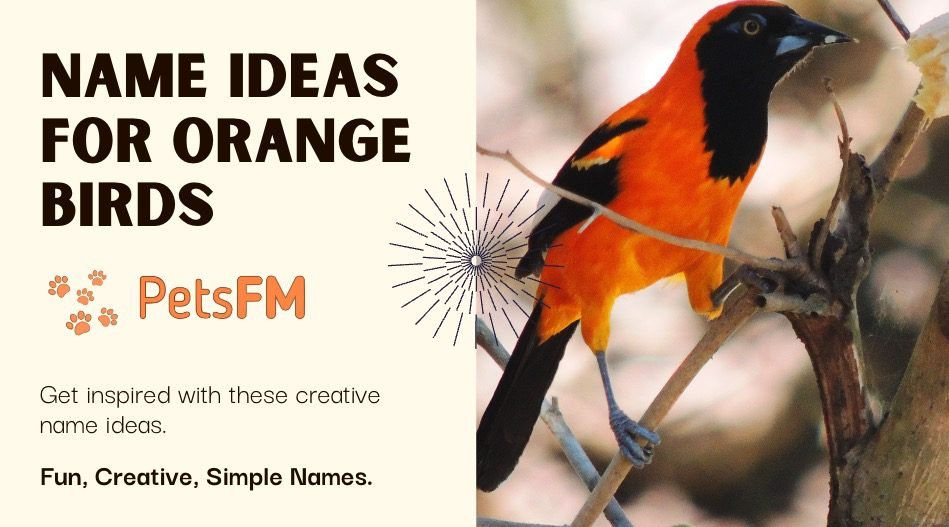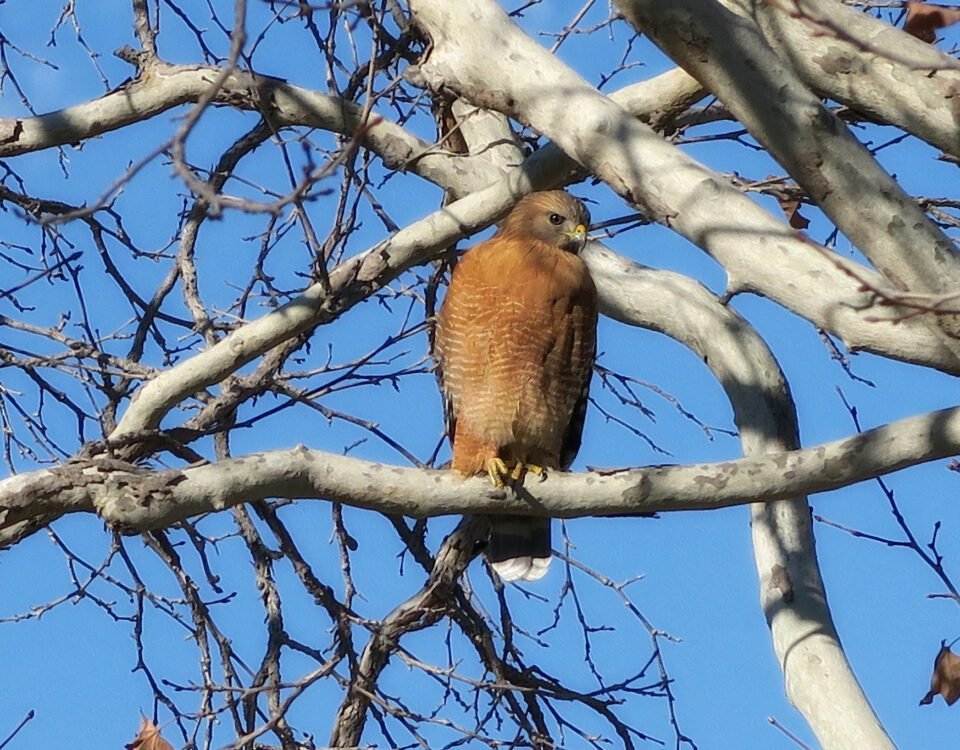


What’s the meaning of Red Cardinal at window? Is it good fortune?
October 26, 2023


100+ Bird Names In Telugu With Translation in English
November 9, 2023French, a language known for its elegance and romantic allure, is deeply embedded in the cultural fabric of France and other Francophone regions. Its linguistic charm is particularly evident in the diverse and poetic vocabulary used to describe nature.
With their vivid plumage and melodious calls, birds occupy a special place in French literature and folklore. In the French cultural context, these avian creatures are more than just residents of the sky; they embody a range of emotions, dreams, and philosophical ideas.
This article will explore various bird names in French, offering their English translations and exploring their cultural significance within the French milieu.
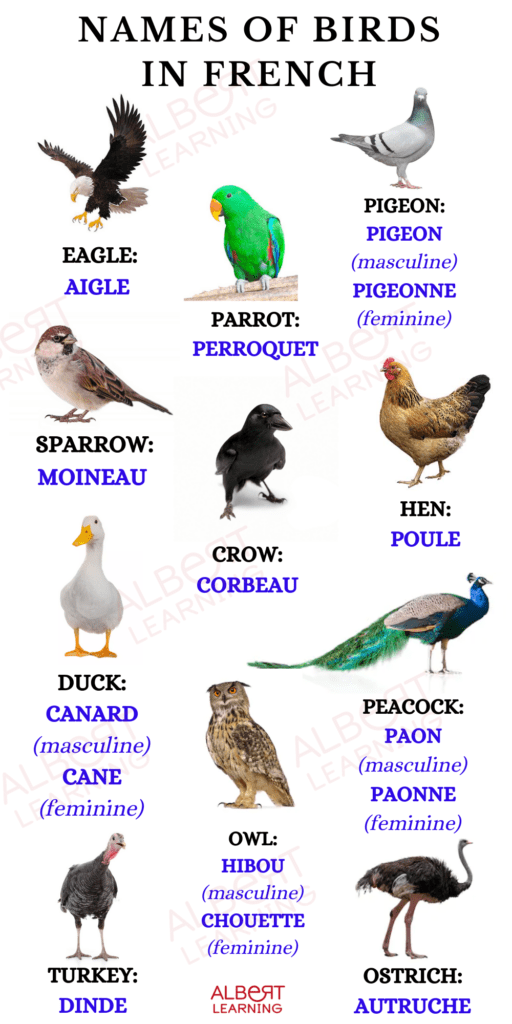

Name of Birds in French. Image: Abert Learning
100 Bird Names In French
1: Moineau (Sparrow)
Cherished for its delightful chirps in bustling French cities and tranquil villages, the moineau (sparrow) easily captures hearts, symbolizing joy and simplicity.
2: Paon (Peacock)
In French culture, the paon (peacock) stands as a symbol of elegance and splendor, displaying a stunning array of colors and epitomizing the pinnacle of avian beauty.
3: Pigeon (Pigeon)
A common sight in urban gardens and yards, the pigeon embodies serenity in France, often representing peace and unity with its gentle presence.
4: Corbeau (Crow)
Ubiquitous and astute, the corbeau (crow) symbolizes adaptability in France, thriving in varied environments from bustling urban areas to the remote countryside.
5: Perroquet (Parrot)
Known for their vibrant colors and ability to mimic sounds, perroquets (parrots) are beloved companions in France, bringing joy to homes with their lively chatter.
6: Aigle (Eagle)
Dominating the skies, the Aigle (eagle) symbolizes power and precision in French culture and is known for its impeccable hunting skills.
7: Hibou (Owl)
Shrouded in the mystery of night, the hibou (owl), with its eerie calls, is often regarded as a wise figure in numerous French stories and folklore.
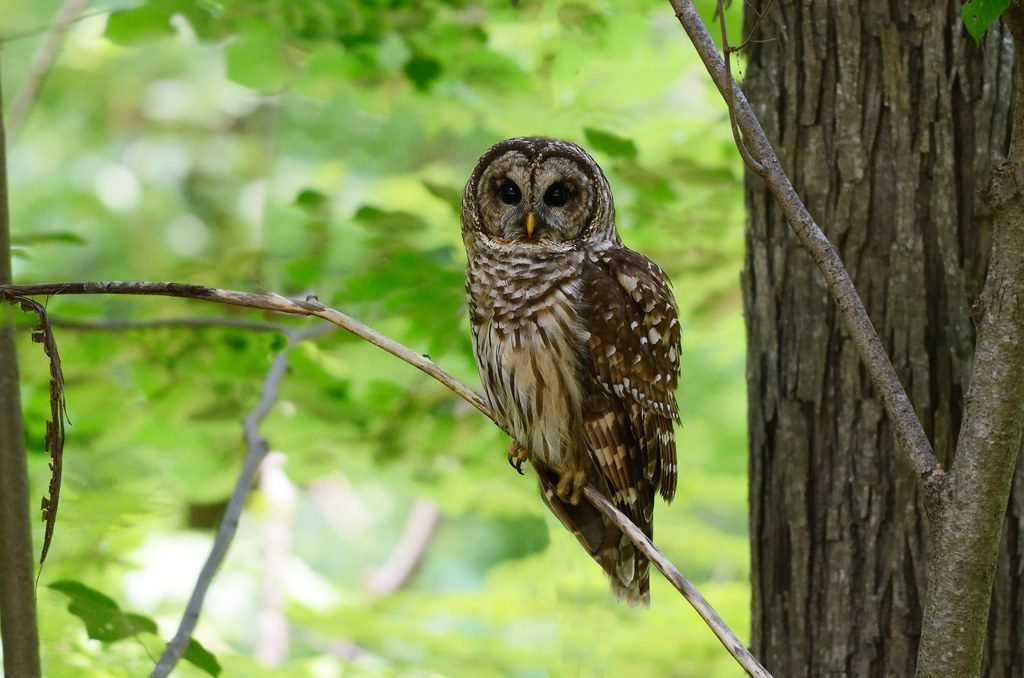

Also, Read: Can You Hunt Owls? Everything You Need to Know About Owl Hunting
8: Martin-pêcheur (Kingfisher)
Frequenting water bodies, the martin-pêcheur (kingfisher) amazes with its swift, elegant dives to catch fish with remarkable skill, symbolizing agility and precision.
9: Pic (Woodpecker)
Recognized by their rhythmic pecking on trees, pics (woodpeckers) play an essential role in French forest ecosystems with their characteristic behavior.
10: Grue (Crane)
With their elegant stature, grues (cranes) are a spectacle in wetlands, known for their synchronized and melodious courtship rituals in French culture.
11: Canard (Duck)
With their serene glides in calm waters, canards (ducks) are noted for their gentle quacks and amusing waddles, symbolizing tranquility and grace.
12: Cygne (Swan)
Effortlessly moving across waters, cygnes (swans), with their immaculate feathers, often feature in French romantic stories and legends, symbolizing purity and elegance.
13: Coucou (Cuckoo)
The arrival of spring in France is heralded by the melodious songs of the coucou (cuckoo), bringing the listeners joy and a touch of nostalgia.
14: Martinet (Myna)
A common city dweller, the martinet (myna) is friendly and vocal, enlivening urban environments in France with energetic calls, symbolizing adaptability and sociability.
15: Colombe (Dove)
Embodying peace and calm, the Colombe’s (dove) soothing coos are a familiar and harmonious element of early morning soundscapes in France.
16: Vautour (Vulture)
Despite their often misunderstood appearance, vautours (vultures) are crucial to French ecosystems, feeding on carrion and thus contributing to environmental cleanliness.
17: Caille (Quail)
Elusive and tiny, cailles (quails) excel at concealing themselves in French grasslands and are noted for their distinctive musical calls, symbolizing subtlety and elusiveness.
18: Faucon (Falcon)
Respected for their exceptional flying abilities, faucons (falcons) are known for their speed and skill in capturing prey mid-air, symbolizing swiftness and precision.
19: Héron (Heron)
Elegant and stately, hérons (herons) frequently stand motionless near water in France, patiently waiting to catch their prey with their long necks, symbolizing patience and focus.
20: Pingouin (Penguin)
Adapted to colder regions, pingouins (penguins) may appear clumsy on land but are swift and graceful underwater swimmers, symbolizing adaptability and resilience.
21: Flamant (Flamingo)
Flamants, with their striking pink color and unique one-legged stance, are captivating in French marshy areas, embodying grace and a distinctive charm.
22: Canari (Canary)
In France, canaris are treasured for their vibrant colors and melodic songs, often kept as cheerful and melodious household pets.
23: Colibri (Hummingbird)
Colibris enchant with their rapid wing movements and ability to hover near flowers, symbolizing agility and the beauty of nature in French culture.
24: Autruche (Ostrich)
Originating from Africa, autruches, these flightless giants, are known for their remarkable speed on land, symbolizing strength and endurance.
25: Buse (Hawk)
Buses, with incredible vision soar high in the French skies, swiftly and accurately diving to capture their prey, epitomizing keen observation and precision.


Hawks Claws
26: Pie (Magpie)
With their striking color contrast, pies are curious birds in France, often observed collecting shiny objects, symbolizing curiosity and intelligence.
27: Corbeau (Raven)
Larger than crows, corbeaux have deep, resonant calls and are commonly associated with France’s wild, untamed landscapes.
28: Perdrix (Partridge)
Robust and hearty, perdrixes fill the French wilderness with melodic calls, predominantly heard in rural areas, symbolizing the spirit of the countryside.
29: Pélican (Pelican)
Easily recognized by their large throat pouches, pélicans are adept fishermen in France, often seen scooping up fish from water bodies.
30: Pinson (Finch)
Small and lively, pinsons bring joy to French gardens with their cheerful chirping, adding vibrant sounds and colors to the natural chorus.
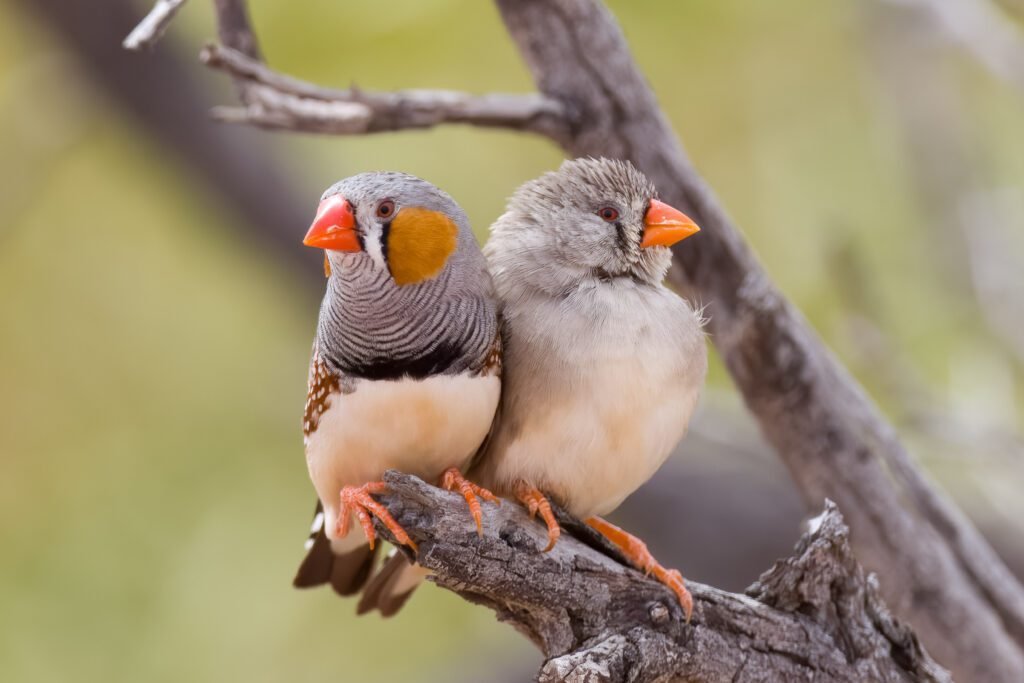

Finches
31: Milan (Kite)
Elegantly navigating the French skies, milans are notable for their V-shaped tails and are often silhouetted against city skylines.
32: Alouette (Lark)
Famed for their high, spiraling flights, Alouettes enchant with their melodious songs in France, inspiring poets and musicians alike.
33: Martinet (Swift)
Martinet, known for their remarkable speed, spend most of their life in the air, often nesting high on French city buildings.
34: Rossignol (Nightingale)
Steeped in legend, Rossignol mesmerizes with their nocturnal songs in France, adding musical beauty to many quiet nights.
35: Cacatoès (Cockatoo)
Native to Australia, cacatoès are recognized in France for their vibrant crests and talent for mimicking diverse sounds.
36: Albatros (Albatross)
Majestic rulers of the sea, Albatros are admired for their wide wingspans that enable effortless glides over oceans.
37: Étourneau (Starling)
Étourneaux are known for their captivating group flight displays, moving in vast, synchronized formations in the French sky.
38: Gallinule (Moorhen)
Inhabitants of water edges, gallinules in France are distinguished by their bright red bills and distinctive forehead shields.
39: Choucas (Jackdaw)
Members of the crow family, choucas, have a notable silver-grey head and are known for their playful and social behavior in France.
40: Sterne (Tern)
Expert sea hunters, sternes demonstrate efficient diving techniques in France, plunging headfirst to catch fish with precision.
41: Rouge-gorge (Robin)
Rouge-gorges, with their bright orange breasts, are associated with winter in many Western cultures, often appearing on festive greeting cards.


Robin
42: Mouette (Seagull)
Mouettes, easily recognized by their loud calls, are common along coastlines and have adapted well to urban environments in France.
43: Toucan (Toucan)
Toucans, with their large, colorful bills, are a vibrant presence in the rainforests of South America and fascinate with their exotic appearance.
44: Faisan (Pheasant)
Faisans are striking ground birds, known for their varied plumage in France, and have long been associated with traditional hunting.
45: Ibis (Ibis)
Respected since ancient times, ibis use their curved beaks for foraging in wetlands and muddy areas, symbolizing adaptation and survival.
46: Freux (Rook)
Common around French farmlands, freux, identifiable by their bare faces, thrive in social groups, symbolizing community and cooperation.
47: Bruant (Bunting)
Small and melodious, bruants enchant with their colorful appearance in France, endearing themselves to birdwatchers and nature enthusiasts.
48: Cormoran (Cormorant)
Cormorans, known for their distinct pose with wings outstretched, dive skillfully to catch fish from the depths, symbolizing agility and precision.
49: Courlis (Curlew)
With their long, curved beaks, courlis elegantly forage in French marshlands, adept at extracting prey from muddy soils.
50: Gélinotte (Grouse)
Adapted to colder regions, gélinottes blend seamlessly into snow-covered terrains with their patterned plumage, symbolizing camouflage and resilience.
51: Pouillot véloce (Chiffchaff)
Recognizable by their repetitive tunes, pouillots véloces flit through French trees, filling the air with melodic songs.
52: Chardonneret élégant (Goldfinch)
Chardonnerets élégants brighten French gardens with colorful plumage, adding harmonious melodies to the natural soundscape.
53: Chouette effraie (Barn Owl)
Often inhabiting old structures, chouettes effraies captivate with their ghostly appearance and haunting calls in France.
54: Huppe fasciée (Hoopoe)
Notable for their striking crests and patterned wings, huppes fasciées search the ground with long beaks for sustenance in France.
55: Balbuzard pêcheur (Osprey)
Magnificent raptors, balbuzards pêcheurs dive into the waters, catching fish precisely, recognized by their distinctive eye masks.
56: Crave à bec rouge (Chough)
Bright blackbirds, craves à bec rouge stand out with their vivid red bills and legs, often seen in rugged terrains in France.
57: Traquet motteux (Wheatear)
Traquets motteux are known for their quick tail flicks in France, creating a visual akin to gentle waves on land.
58: Moineau domestique (House Sparrow)
Everywhere in urban areas, moineaux domestiques, with their familiar chirps, are an integral part of the human environment in France.
59: Bulbul (Bulbul)
Primarily found in the East, bulbuls are celebrated for their melodic songs, inspiring various art forms.
60: Tourterelle rieuse (Laughing Dove)
The continuous, chuckle-like coos of the tourterelle rieuse resonate peacefully during mornings and evenings in many regions.
61: Rollier (Roller)
Perched high, rolliers display a stunning blend of turquoise and brown, surveying their territories with a majestic gaze at French landscapes.
62: Pigeon ramier (Wood Pigeon)
Robust pigeons ramiers, with their subtle iridescence, roam forests in France, searching endlessly for fruits and seeds.
63: Avocette (Avocet)
Sporting elegant black and white colors, avocettes skillfully use their curved bills to sift through water for small prey in French wetlands.
64: Ganga (Sandgrouse)
Robust and adapted to desert environments, gangas congregate at oases, uniquely using their feathers to absorb and transport water.
65: Martinet pâle (Pallid Swift)
Characterized by their crescent-shaped wings and lighter underparts, martinet pâles prefer nesting in secluded spots, especially on cliff faces.
66: Quiscale (Common Grackle)
With glossy, dark plumage, quiscales stand out with their striking pale eyes, commonly seen foraging in open landscapes in France.
67: Guêpier d’Europe (European Bee-Eater)
Vibrantly colored, guêpiers d’Europe showcase aerial agility, skillfully hunting and consuming flying insects during flight.
68: Loriot (Golden Oriole)
Males, resplendent in yellow with contrasting black wings, are known for their musical calls, enhancing the natural soundscape in France.


Golden Oriole
69: Caille des blés (Common Quail)
Well camouflaged in grassy terrains, cailles des blés emit distinctive calls that resonate throughout their habitats in France.
70: Œdicnème criard (Stone-Curlew)
These birds possess large, mesmerizing yellow eyes and are active at night, their haunting calls echoing in the stillness of French landscapes.
71: Cigogne blanche (White Stork)
Tall and majestic, the cigogne blanche is recognized for its large nests in trees, long legs, and striking black wings against a white body.
72: Martin-pêcheur pie (Pied Kingfisher)
Exhibiting striking black and white feathers, martin-pêcheur pie is adept at hovering over the water before diving rapidly to snatch fish.
73: Grue cendrée (Common Crane)
This tall, grey bird often flies in large groups in France, and its intricate dancing rituals are a fascinating spectacle.
74: Messager sagittaire (Secretary Bird)
With its long legs and eagle-like appearance, this unique bird excels in hunting snakes, resembling a blend between a crane and an eagle.
75: Gypaète barbu (Bearded Vulture)
Distinct from other vultures, the gypaète barbu prefers bones, featuring a unique appearance and playing a vital role in the ecosystem.
76: Outarde de MacQueen (MacQueen’s Bustard)
A large and impressive bird, outarde de MacQueen is admired for its aerial display dances, often performed to attract mates.
77: Spatule blanche (Eurasian Spoonbill)
Featuring a distinctive spoon-shaped bill, spatule blanche skillfully uses it to sift through water for fish, providing an intriguing sight.
78: Corneille mantelée (Hooded Crow)
Primarily found in the Middle East, the Corneille mantelée is notable for its grey hood, contrasting with its otherwise black body.
79: Martin-pêcheur pie (Pied Kingfisher)
Recognizable by its sharp call, this kingfisher is an expert at diving into water quickly and precisely, its black and white plumage making it distinct.
80: Perdrix bartavelle (Rock Partridge)
A beautifully marked bird with a red bill, perdrix bartavelle is adept at camouflage, often blending seamlessly with its surroundings.
81: Échasse blanche (White-tailed Lapwing)
This elegant bird, often flying over French deserts, is recognized for its round wings and distinctive yellow legs.
82: Tourterelle turque (Eurasian Collared Dove)
Known for the rhythmic movement of its tail accompanying its soft calls, these doves are commonly observed in pairs in France.
83: Martinet des palmes (African Palm Swift)
A swift flyer, this bird weaves its way around palm trees and constructs its nests using palm leaves, a common sight in warmer regions.
84: Bergeronnette printanière (Yellow Wagtail)
Vibrantly yellow, this bird is famous in France for its constant tail wagging, especially noticeable during the spring season.
85: Martinet noir (Common Swift)
With its sharply-pointed wings, this fast-flying bird is adept at catching insects mid-flight, a frequent sight in the French skies.
86: Martin-pêcheur de Smyrne (White-breasted Kingfisher)
Featuring a blue upper body and white underbelly, this kingfisher is often found near water bodies in French forests.
87: Alouette des champs (Eurasian Skylark)
Famed in France for its singing ability, this bird soars high in the sky while delivering beautiful melodies.
88: Pigeon ramier (Common Wood Pigeon)
This grey pigeon, adorned with white markings on its neck, is known in France for its deep, resonant voice echoing through forests.
89: Guêpier d’Europe (European Bee-eater)
A stunningly golden bird, it excels in aerial grace in France and is often seen hunting insects in flight.
90: Grèbe castagneux (Little Grebe)
A small aquatic bird known for its surprising dives in French waters, often reemerging unexpectedly at different locations on the surface.
91: Tisserin gendarme (Southern Masked Weaver)
Adorned with a vivid yellow neck and a dark facial mask, males exhibit their nesting prowess, weaving intricate nests over water bodies.
92: Hirondelle de rochers (Eurasian Crag Martin)
Fond of cliffs, this bird, with its brownish-grey plumage, is notable for its unique nests and uplifting song in rocky French habitats.
93: Sirli du désert (Greater Hoopoe Lark)
Well-suited for desert environments, this bird showcases a striking combination of black, white, and brown feathers in France, complete with a distinctive crest.
94: Bruant ortolan (Cinereous Bunting)
Commonly perched on poles in France, this bird enchants with its sweet song, its brown plumage accented by pale markings on the face.
95: Souimanga brillant (Shining Sunbird)
The male sparkles with a purple chest in France, swiftly moving among flowers and playing a crucial role in pollination.
96: Crave à bec rouge (Red-billed Chough)
With its glossy dark plumage, this bird stands out for its red bill and feet in France, preferring coastal and mountainous regions.
97: Souimanga d’Asie (Purple Sunbird)
Males display dazzling purple and green plumage in France, energetically flitting from flower to flower in search of nectar.
98: Bulbul des jardins (Yellow-vented Bulbul)
Recognizable by its yellow tail, this cheerful bird has become a familiar sight even in urban areas of France.
99: Vanneau éperonné (Spur-winged Lapwing)
This bird features distinctive facial patterns in France and emits a unique rattling sound with its wings during flight.
100: Martin-pêcheur d’Europe (Common Kingfisher)
Vibrant and striking, this adept diver plunges into French water bodies with remarkable skill to catch fish.
How To Say Bird In French
In French, the word for ‘bird’ is “oiseau.”
Cultural and Literary Significance of Birds in French
The term “oiseau” encompasses various bird species, each bearing significant cultural, literary, and historical connotations within the Francophone community. Birds in French culture often symbolize freedom, beauty, and wisdom.
French Proverbs Involving Birds
“Chacun reconnaît l’oiseau à son chant” – This proverb, meaning “Everyone recognizes the bird by its song,” underscores the importance of individual identity and characteristics.
“L’oiseau qui vole connaît la grandeur du ciel” translates to “The bird that flies knows the vastness of the sky,” emphasizing the value of personal experience and exploration.
Birds of Prey in French Traditions
In French traditions, raptors such as eagles, hawks, and falcons are admired for their strength and prowess. Their French names reflect their majestic and powerful nature.
Melodic Birds in French Poetry
Birds like nightingales, larks, and finches, celebrated for their melodic songs, often symbolize romance and beauty in French poetry. Their names in French capture this essence of melody and charm.
French Idioms Featuring Birds
The French language is enriched with idioms and phrases that include bird names, reflecting the region’s profound cultural and linguistic intricacies.
Native Birds of France
Typical birds native to the varied landscapes of France, such as the European robin, Blue tit, and French partridge, represent the local avifauna and natural heritage.


Fifteen birds indigenous to France, including a falcon, buzz
Mystical Birds of French Folktales
French folklore is abundant with tales of mythical birds, like the phoenix, known for its cycle of rebirth, creating captivating stories and myths.
Bird Symbolism in Ancient French Dynasties
In ancient French history, birds held significant symbolic importance, often serving as emblems and representing various meanings and messages in heraldry and art.
Conclusion
From the enchanting songs of the Rossignol (Nightingale) to the noble flight of the eagle, the world of birds holds a special place in French culture, language, and traditions.
The idioms, proverbs, and folklore that feature these birds provide a window into the natural splendor of France. These aspects underscore the profound bond of the French-speaking community with these avian marvels.
Birds are quintessential symbols of French heritage, representing freedom and serving as messengers in romantic tales or as icons in cultural narratives. They are a reminder of the seamless and harmonious interconnection between nature and culture.
![100+ Bird Names In French With English Translation [UPDATED]](https://petsfm.com/wp-content/uploads/2023/11/Screenshot-2023-11-24-at-11.07.46 PM-960x541.jpg)
